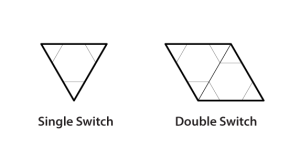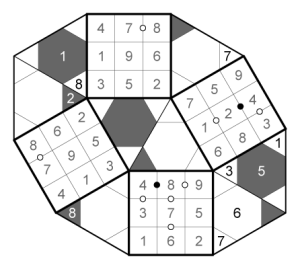This may be the most obscure puzzle idea I’ve come up with yet. Even though it’s hard to explain, I like how it solves.
Rules
Place the numbers 1-9 so that they appear exactly once in each 3×3 block of square cells.
Standard Kropki rules apply to borders between square cells:
- A black dot on the border between two square cells indicates that the ratio of those cells is exactly 2. A white dot on the border between two square cells indicates that the difference between those cells is exactly 1. A border between two square cells with no dot indicates that neither of these properties applies. (The border between “1” and “2” could have either a black or a white dot.)
Between the 3×3 blocks of square cells are switches, which consist of 3 triangles and 1 hexagon.

Exactly one cell from each switch must be shaded (for double switches, one cell from each side must be shaded). Shaded cells cannot share an edge. A switch relates triplets from different 3×3 blocks in the following three possible combinations: one triangle, one hexagon, or two triangles.

If the switch cell (or one of the two cells in the case of two triangles) is shaded, both triplets must contain the same three numbers. If the cell (or both cells in the case of two triangles) is unshaded, both triplets must contain different numbers. If a switch cell containing a number is shaded, any triplets touching that cell must contain that number. If the cell is unshaded, any triplets touching that cell must not contain that number.
Example


Puzzles
All of the puzzles can be found organized in this printable PDF, or in the images below.
PDF Kropki Switch
01. Medium
02. Hard

03. Expert

